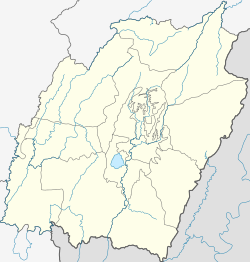
Back মৈরাং (মণিপুর) Bengali/Bangla মৈরাং BPY Moirāng CEB Moirang Finnish मोइरांग Hindi Moirang Italian Moirang Malagasy ꯃꯣꯏꯔꯥꯡ MNI Moirang Malay मैरां NEW
Moirang
Keke Moilang, Kege Moirang | |
|---|---|
town | |
 A statue of Netaji Subhashchandra Bose in the INA Memorial Complex in Moirang | |
| Coordinates: 24°30′N 93°46′E / 24.5°N 93.77°E | |
| Country | India |
| State | Manipur |
| District | Bishnupur |
| Elevation | 766 m (2,513 ft) |
| Population (2001) | |
• Total | 16,684 |
| Language(s) | |
| • Official | Meitei (Manipuri) |
| Time zone | UTC+5:30 (IST) |
| Vehicle registration | MN |
| Website | manipur |
Moirang (Meitei: /moi.rāŋ/[1]) is a town in the Indian state of Manipur, best known for the tentatively listed UNESCO World Heritage Sites of the Keibul Lamjao Conservation Area (KLCA), covering Keibul Lamjao National Park (KLNP), the world's only floating national park,[2][3] the buffer of Loktak Lake (140 sq km) and Pumlen Pat (43 sq. km).[4][5] It is best known for the being the place of origin of the ancient epic legend of Khamba and Thoibi, one of the seven epic cycles of incarnations of Meitei mythology and folklore.[6][7] Nationwide, it is also famous for the INA War Museum in the INA Martyrs' Memorial Complex, where Colonel Shaukat Malik of the Indian National Army hoisted the Tricolour for the first time on Indian soil on 14 April 1944.[8] It is situated approximately 45 km (28 mi) south of the state capital Imphal. It has an area of 269 km2 (104 sq mi) with a population of 62,187 in 67 villages. There are 12 Panchayats in this block.
- ^ Sharma, H. Surmangol (2006). "Learners' Manipuri-English dictionary". dsal.uchicago.edu (in Manipuri and English). University of Chicago. p. 154. Retrieved 16 March 2023.
moirāng ꯃꯣꯏꯔꯥꯡ /moi.raŋ/ n. 1) Moirang: name of a historically important place in Manipur. 2) name of a Meitei clan.
- ^ "The Floating Islands of India". earthobservatory.nasa.gov. 7 May 2018. Retrieved 13 March 2023.
The largest island is home to the Keibul Lamjao, the world's only floating national park. It serves as a habitat for the endangered brow-antlered sangai, or "dancing deer," whose hooves have adapted to the island's spongy ground. The park, covering 15 square miles (40 km2), was specifically created to preserve the deer, which were once thought to be extinct.
- ^ McKechnie, Ben. "The world's only floating national park". www.bbc.com. Retrieved 13 March 2023.
- ^ Centre, UNESCO World Heritage. "Keibul Lamjao Conservation Area". UNESCO World Heritage Centre. Retrieved 13 March 2023.
- ^ "Keibul Lamjao Conservation Area | For UNESCO World Heritage Travellers". www.worldheritagesite.org. Retrieved 13 March 2023.
- ^ Oinam, Bhagat; Sadokpam, Dhiren A. (11 May 2018). Northeast India: A Reader. Taylor & Francis. pp. 236, 237. ISBN 978-0-429-95320-0.
Numerous manuscripts of the Moirang region dwell on the theme of love. One of the most popular stories refers to the seven pairs of lovers who are regarded as incarnations of the same souls in different generations or age.
- ^ Datta, Amaresh (1987). Encyclopaedia of Indian Literature: A-Devo. India: Sahitya Akademi. p. 349. ISBN 978-81-260-1803-1.
The epic ballad cycle of the incarnations of Moirang which is nine in number according to some and only seven according to others is a grand majestic saga of the eternal triangle in which generations after generations would find reflections of the various hopes, ideals and aspirations of each age.
- ^ Sharma, G. Amarjit (5 July 2021). State vs. Society in Northeast India: History, Politics and the Everyday. SAGE Publishing India. p. 82. ISBN 978-93-91370-45-9.

